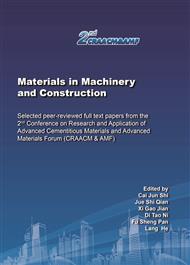[1]
Shi Y, Wan J, Li J, et al. Elucidating the interfacial evolution and anisotropic dynamics on silicon anodes in lithium-ion batteries, J. Nano Energy, 2019,61:304-310.
DOI: 10.1016/j.nanoen.2019.04.074
Google Scholar
[2]
Zuo X, Zhu J, Müller-Buschbaum P, et al. Silicon based lithium-ion battery anodes: A chronicle perspective review, J. Nano Energy, 2017,31:113-143.
DOI: 10.1016/j.nanoen.2016.11.013
Google Scholar
[3]
Su M, Liu S, Tao L, et al. Silicon@graphene composite prepared by spray–drying method as anode for lithium ion batteries, J. Journal of Electroanalytical Chemistry, 2019,844:86-90.
DOI: 10.1016/j.jelechem.2019.04.072
Google Scholar
[4]
Ahn S, Nara H, Yokoshima T, et al. Effect of enhanced structural stability of Si-O-C anode by carbon nanotubes for lithium-ion battery, J. Materials Letters, 2019,245:200-203.
DOI: 10.1016/j.matlet.2019.03.012
Google Scholar
[5]
Wang P P, Zhang Y X, Fan X Y, et al. Synthesis of Si nanosheets by using Sodium Chloride as template for high-performance lithium-ion battery anode material, J. Journal of Power Sources, 2018,379:20-25.
DOI: 10.1016/j.jpowsour.2018.01.030
Google Scholar
[6]
Yu K, Zhang H, Qi H, et al. Rice Husk as the Source of Silicon/Carbon Anode Material and Stable Electrochemical Performance, J. ChemistrySelect, 2018,3(19):5439-5444.
DOI: 10.1002/slct.201800650
Google Scholar
[7]
An W, Xiang B, Fu J, et al. Three-dimensional carbon-coating silicon nanoparticles welded on carbon nanotubes composites for high-stability lithium-ion battery anodes, J. Applied Surface Science, 2019,479:896-902.
DOI: 10.1016/j.apsusc.2019.02.145
Google Scholar
[8]
Chen H, He S, Hou X, et al. Nano-Si/C microsphere with hollow double spherical interlayer and submicron porous structure to enhance performance for lithium-ion battery anode, J. Electrochimica Acta, 2019,312:242-250.
DOI: 10.1016/j.electacta.2019.04.170
Google Scholar
[9]
Wang M, Fan L, Huang M, et al. Conversion of diatomite to porous Si/C composites as promising anode materials for lithium-ion batteries, J.Journalof Power Sources, 2012,219:29-35.
DOI: 10.1016/j.jpowsour.2012.06.102
Google Scholar
[10]
Wang J, Liu D, Wang Y, et al. Dual-carbon enhanced silicon-based composite as superior anode material for lithium ion batteries, J. Journal of Power Sources, 2016,307:738-745.
DOI: 10.1016/j.jpowsour.2016.01.040
Google Scholar
[11]
Tang X, Wen G, Song Y. Novel scalable synthesis of porous silicon/carbon composite as anode material for superior lithium-ion batteries, J.Journal of Alloys and Compounds, 2018,739:510-517.
DOI: 10.1016/j.jallcom.2017.12.331
Google Scholar
[12]
Xu Y, Zhang C, Kuang S, et al. Facile synthesis and electrochemical performances of activated bamboo charcoal supported MoS2 nanoflakes as anodes materials for lithium-ion batteries, J. Journal of Electroanalytical Chemistry, 2019,847:113265.
DOI: 10.1016/j.jelechem.2019.113265
Google Scholar
[13]
Wei Y, Yan Y, Zou Y, et al. Sulfonated polyaniline coated bamboo-derived biochar/sulfur cathode for Li-S batteries with excellent dual conductivity and polysulfides affinity, J. Electrochimica Acta, 2019,310:45-57.
DOI: 10.1016/j.electacta.2019.04.067
Google Scholar
[14]
Wei Y, Yan Y, Zou Y, et al. The ternary PANI@BDC/S composite cathode with enhanced electrochemical performance in lithium-sulfur batteries, J. Journal of Electroanalytical Chemistry, 2019,839:149-159.
DOI: 10.1016/j.jelechem.2019.03.014
Google Scholar
[15]
Zhuang X, Zhang Y, He L, et al. Scalable synthesis of nano-Si embedded in porous C and its enhanced performance as anode of Li-ion batteries, J.Electrochimica Acta, 2017,249:166-172.
DOI: 10.1016/j.electacta.2017.07.092
Google Scholar
[16]
Zhu G, Gu Y, Wang Y, et al. Neuron like Si-carbon nanotubes composite as a high-rate anode of lithium ion batteries, J. Journal of Alloys and Compounds, 2019,787:928-934.
DOI: 10.1016/j.jallcom.2019.02.186
Google Scholar
[17]
Majeed M. K,Ma G,Cao Y, et al. Metal Organic Frameworks-Derived Mesoporous Si/SiOx @NC Nanospheres as a Long-Lifespan Anode Material for Lithium Ion Batteries, J. Chemistry - A European Journal, (2019).
DOI: 10.1002/chem.201903043
Google Scholar
[18]
Wang Q, Guo C, He J, et al. Fe2O3/C-modified Si nanoparticles as anode material for high-performance lithium-ion batteries, J. Journal of Alloys and Compounds, 2019,795:284-290.
DOI: 10.1016/j.jallcom.2019.05.038
Google Scholar
[19]
Galvez-Aranda D E, Verma A, Hankins K, et al. Chemical and mechanical degradation and mitigation strategies for Si anodes, J. Journal of Power Sources, 2019,419:208-218.
DOI: 10.1016/j.jpowsour.2019.02.054
Google Scholar
[20]
Wang K, Huang Y, Yu M, et al. A facile route to synthesize hollow Si-Ni3Sn2 nanospheres@reduced graphene oxide nanocomposites for high performance lithium-ion batteries, J. Journal of Alloys and Compounds, 2017,698:547-554.
DOI: 10.1016/j.jallcom.2016.12.216
Google Scholar
[21]
Tao J, Lu L, Wu B, et al. Dramatic improvement enabled by incorporating thermal conductive TiN into Si-based anodes for lithium ion batteries, J. Energy Storage Materials, (2019).
DOI: 10.1016/j.ensm.2019.12.025
Google Scholar
[22]
Liu M, Gao H, Hu G, et al. Facile preparation of core-shell Si@Li4Ti5O12nanocomposite as large-capacity lithium-ion battery anode, J. Journal of Energy Chemistry, 2020,40:89-98.
DOI: 10.1016/j.jechem.2019.02.011
Google Scholar
[23]
Zhang L, Deng J, Liu L, et al. Hierarchically Designed SiOx/SiOy Bilayer Nanomembranes as Stable Anodes for Lithium Ion Batteries, J. Advanced Materials, 2014,26(26):4527-4532.
DOI: 10.1002/adma.201401194
Google Scholar
[24]
Chen T, Wu J, Zhang Q, et al. Recent advancement of SiOx based anodes for lithium-ion batteries, J. Journal of Power Sources, 2017,363:126-144.
DOI: 10.1016/j.jpowsour.2017.07.073
Google Scholar
[25]
Xiao Z, Yu C, Lin X, et al. Uniform coating of nano-carbon layer on SiOx in aggregated fluidized bed as high-performance anode material, J. Carbon, 2019,149:462-470.
DOI: 10.1016/j.carbon.2019.04.051
Google Scholar
[26]
Ma B, Luo J, Peng J, et al. Hetero geneous dual-wrapped architecture of hollow SiOx/MoS2-CNTs nanohybrids as anode materials for lithium-ion batteries, J. Journal of Electroanalytical Chemistry, (2019).
DOI: 10.1016/j.jelechem.2019.04.054
Google Scholar
[27]
Li G, Li J, Yue F, et al. Reducing the volume deformation of high capacity SiOx/G/C anode toward industrial application in high energy density lithium-ion batteries, J. Nano Energy, 2019,60:485-492.
DOI: 10.1016/j.nanoen.2019.03.077
Google Scholar
[28]
Fukata N, Mitome M, Bando Y, et al. Lithium ion battery anodes using Si-Fe based nanocomposite structures, J. Nano Energy, 2016,26:37-42.
DOI: 10.1016/j.nanoen.2016.05.007
Google Scholar
[29]
An W, Gao B, Mei S, et al. Scalable synthesis of ant-nest-like bulk porous silicon for high-performance lithium-ion battery anodes, J. Nature Communications, 2019,10(1).
DOI: 10.1038/s41467-019-09510-5
Google Scholar
[30]
Tamirat A G, Hou M, Liu Y, et al. Highly stable carbon coated Mg2Si intermetallic nanoparticles for lithium-ion battery anode, J. Journal of Power Sources, 2018,384:10-17.
DOI: 10.1016/j.jpowsour.2018.02.008
Google Scholar
[31]
Chen Z, Ye J, Qin R, et al. Carbon particles modified macroporous Si/Ni composite as an advanced anode material for lithium ion batteries, J. International Journal of HydrogenEnergy, 2019,44(2):1078-1087.
DOI: 10.1016/j.ijhydene.2018.11.065
Google Scholar


